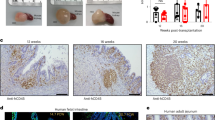Abstract
Studies have shown that bone marrow cells have the potential to differentiate into a variety of cell types. Here we show that bone marrow cells can repopulate the epithelia of the human gastrointestinal tract. Epithelial cells of male donor origin were distributed in every part of the gastrointestinal tract of female bone marrow transplant recipients. Donor-derived epithelial cells substantially repopulated the gastrointestinal tract during epithelial regeneration after graft-versus-host disease or ulcer formation. Regeneration of gastrointestinal epithelia with donor-derived cells in humans shows a potential clinical application of bone marrow–derived cells for repairing severely damaged epithelia, not only in the gastrointestinal tract but also in other tissues.
This is a preview of subscription content, access via your institution
Access options
Subscribe to this journal
Receive 12 print issues and online access
$209.00 per year
only $17.42 per issue
Buy this article
- Purchase on Springer Link
- Instant access to full article PDF
Prices may be subject to local taxes which are calculated during checkout




Similar content being viewed by others
References
Cheng, H. & Leblond, C.P. Origin, differentiation and renewal of the four main epithelial cell types in the mouse small intestine. I. Columnar cell. Am. J. Anat. 141, 461–474 (1974).
Bach, S.P., Renehan, A.G. & Potten, C.S. Stem cells: the intestinal stem cell as a paradigm. Carcinogenesis 21, 469–476 (2000).
Wright, N.A. in Stem Cells (ed. Potten, C.S.) 315–330 (Academic Press, London, UK, 1997).
Booth, C. & Potten, C.S. Gut instincts: thoughts on intestinal epithelial stem cells. J. Clin. Invest. 105, 1493–1499 (2000).
Negrin, R.S. & Blume, K.G. in Williams Hematology, edn. 13 (ed. Beutler, E.) 209–247 (McGraw-Hill, New York, New York, 2001).
Blau, H.M., Brazelton, T.R. & Weimann, J.M. The evolving concept of stem cell: entity or function? Cell 105, 829–841 (2001).
Petersen, B.E. et al. Bone marrow as a potential source of hepatic oval cells. Science 284, 1168–1170 (1999).
Lagasse, E. et al. Purified hematopoietic stem cell can differentiate into hepatocytes in vivo. Nature Med. 6, 1229–1234 (2000).
Thiese, N.D. et al. Liver from bone marrow in humans. Hepatology 32, 11–16 (2000).
Alison, M.R. et al. Hepatocytes from non-hepatic adult stem cells. Nature 406, 257 (2000).
Orlic, D. et al. Bone marrow cells regenerate infarcted myocardium. Nature 410, 701–705 (2001).
Jackson, K.A. et al. Regeneration of ischemic cardiac muscle and vascular endothelium by adult stem cells. J. Clin. Invest. 107, 1395–1402 (2001).
Guissoni, E. et al. Dystrophin expression in the mdx mouse restored by stem cell transplantation. Nature 401, 390–394 (1999).
Brazelton, T.R., Rossi, F.M.V., Keshet, G.I. & Blau, H.M. From marrow to brain: expression of neuronal phenotypes in adult mice. Science 290, 1775–1779 (2000).
Krause, D.S. et al. Multi-organ, multi-lineage engraftment by a single bone marrow–derived stem cell. Cell 105, 369–377 (2001).
Korbling, M. et al. Hepatocytes and epithelial cells of donor origin in recipients of peripheral blood stem cells. N. Engl. J. Med. 346, 738–746 (2002).
Terada, N. et al. Bone marrow cells adopt the phenotype of other cells by spontaneous cell fusion. Nature 416, 542–545 (2002).
Ying, Q-L. et al. Changing potency by spontaneous fusion. Nature 416, 545–548 (2002).
Wumser, A.E. & Gage, F.H. Cell fusion causes confusion. Nature 416, 485–486 (2002).
McKay, R. A more astonishing hypothesis. Nat. Biotech. 20, 426–427 (2002).
Ishino, S. et al. Loss of material from chromosome arm 1p during malignant progression of meningioma revealed by fluorescent in situ hybridization. Cancer 83, 360–366 (1998).
Nakahori, Y., Mitani, K., Yamada, M. & Nakagome, Y. A human Y-chromosome-specific repeated DNA family (DYZ1) consists of a tandem array of pentanucleotides. Nucleic Acids Res. 14, 7569–7580 (1986).
Acknowledgements
This study was supported in part by grants-in-aid from the Japanese Ministry of Education, Culture, Sports, Science and Technology, the Japanese Ministry of Health, Labor and Welfare, Chiyoda Mutual Life Foundation, Japan Heath Sciences Foundation, and Creative Scientific Research by the Japan Society for the Promotion of Science. The authors would like to thank H. Okano and Y. Tanaka for helpful discussion, T. Mori for providing the clinical information, S. Kakinuma for technical assistance, Y. Iwao for providing the specimens and R. Fujisaki for manuscript preparation.
Author information
Authors and Affiliations
Corresponding author
Ethics declarations
Competing interests
The authors declare no competing financial interests.
Rights and permissions
About this article
Cite this article
Okamoto, R., Yajima, T., Yamazaki, M. et al. Damaged epithelia regenerated by bone marrow–derived cells in the human gastrointestinal tract. Nat Med 8, 1011–1017 (2002). https://doi.org/10.1038/nm755
Received:
Accepted:
Published:
Issue Date:
DOI: https://doi.org/10.1038/nm755
This article is cited by
-
Stem cell therapy combined with controlled release of growth factors for the treatment of sphincter dysfunction
Cell & Bioscience (2023)
-
Field carcinogenesis and biological significance of the potential of the bystander effect: carcinogenesis, therapeutic response, and tissue regeneration
Surgery Today (2023)
-
Early myelostimulation in patients with locally advanced gastric cancer after fluorouracil plus platinum-based neoadjuvant chemotherapy is related to poor prognosis
Cancer Chemotherapy and Pharmacology (2021)
-
A unified model of the hierarchical and stochastic theories of gastric cancer
British Journal of Cancer (2017)
-
Homing of Cultured Endothelial Progenitor Cells and Their Effect on Traumatic Brain Injury in Rat Model
Scientific Reports (2017)



